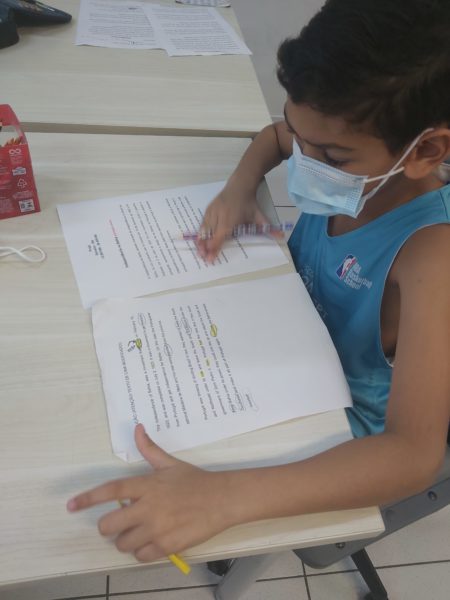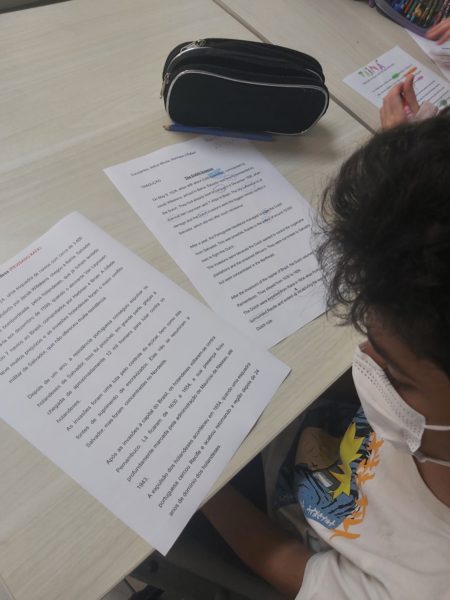Improving pronunciation and fluency in a second language
How can we increase pronunciation and fluency in a second language?
General topic of interest
For the final Festival of Learning of the year, Grade 3B came up with the idea to create an online map of Salvador that can be used to inform and educate people such as tourists about historical people and events that were important to Salvador. The map would show the location which is most significant to the historical person or event and would be accompanied with a text and audio, both in English and Portuguese about it. With the students' native language being Portuguese, the big challenge was how to prepare the students to record their English audio file with correct pronunciation and fluency. We only had a short amount of time to prepare the learners and as each student had a different text to record, we wanted to try to use strategies that would allow the students to work on their pronunciation and fluency with as much autonomy as possible.
Having participated in a Reader's Workshop course in Belo Horizonte, I got to witness how translanguaging and choral reading can be used as strategies to improve reading fluency and pronunciation as well as comprehension. We therefore created a plan to incorporate these strategies as well as audio-assisted reading and collected data to gain a more concrete understanding of the extent in which they helped to achieve the progress that we wanted to see in our learners.
Participants
Grade 3B. All of the students participated in the process, however, we chose 4 students of different levels of English and needs to record an audio before having the chance to practise via choral reading and audio assisted reading to compare with their final recording.
Literature Review
We gave the students their text in English and Portuguese to help them to make meaning of their text. As Anna Becla writes, translation can help "students to understand the connection between languages. It is a necessary and natural activity, because in many common places foreign words are met and they need to be decoded." (https://spswiatki.edu.pl/archiwum/publikacje/translation.pdf)
By using choral reading, our intention was to "provide less skilled readers the opportunity to practice and receive support" and "a model for fluent reading as students listen." (https://www.readingrockets.org/strategies/choral_reading)
We then used audio-assisted reading as a means of improving "sight word recognition", "build fluency skills" and "hear the tone and pace of a skillful reader." (https://www.readingrockets.org/strategies/audio_assisted_reading)
Data collecting approach
Grade 3B learners were asked to read their texts with four of them being recorded. After practising becoming more familiar with their text through the strategies that we applied, we recorded the audios of all the students. Using their final recordings, we were able to compare and see to what extent they had improved in regards to their pronunciation and fluency.
Click on the links below to watch the recordings:
Data collection tools/resources
As well as using the audios to analyse whether the learners had improved as a result of our strategies, we also invited all of the learners to participate in a questionaire to share with us whether they felt the strategies had helped their pronunciation and fluency for the final recording.
Emerging results
Julia’s final version showed greater fluidity and speed of reading. The pronunciation of words such as “success” and “first” were more accurate, “coast” and “thirteen” remained the same. (Julia final recording)
Bruna’s final version had a better quality than her first attempt. This can be seen by analysing her intonation and punctuation, as well as the pronunciation of several words, as “chosen” and “sugar”. (Bruna final recording)
Enzo had many doubts in his first attempt, as we can notice while he reads numbers and pronounces some words, like “March”, “business” and “Northeast”. In his final version, we can see a greater fluency, pronunciation, and confidence in his speech. (Enzo final recording)
It is visible how Marcos improved his fluency and intonation when we listen to both recordings. His final recording showed greater assertiveness in his pronunciation of several words such as “reasons” and “version”. (Marcos final recording)
The questionaire also reflected that the learners felt they benefited from the strategies we used. When asked to give a score between 1 - 10, 68.8% of the students gave a score of 7 or higher when asked whether seeing the text in both languages helped them to make more sense of their text. 75.1% gave a score of 7 or higher when asked whether they felt choral reading with the reference educator helped with their pronunciation and fluency, while 68.8% gave a score of 7 or higher, when asked about the extent they believe audio assisted reading helped them. 75% gave a score of 10 when asked if they believe they showed improvement in the final recording when compared to the first time they read it.
Reflections
Our research shows that it is possible to improve pronunciation and fluency quickly and effectively using the strategies that we used. By looking at their text in both languages, our learners were able to make connections between words and sentences to increase their comprehension and famililarity with their text in an autonomous way and this can be inferred from the greater variety of intonation and confidence in their reading. Choral reading and audio assisted reading provided us with a strategy to improve pronunciation and confidence very quickly. Some words were still pronounced incorrectly which suggests that more focused intervention on specific words alongside the use of choral and audio assisted reading may help us to achieve even better results next time.






